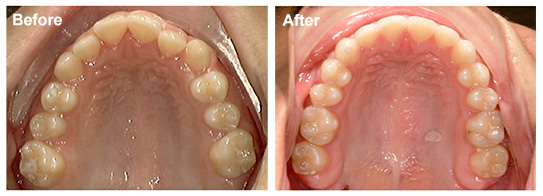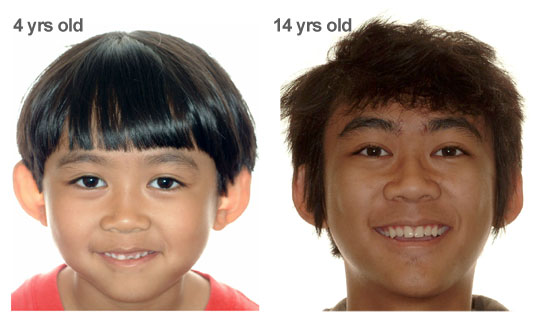
WHEN YOU START your orthodontic treatment, we create a specialized plan just for you! We use many methods and tools to give you a unique, personalized, beautiful, well-balanced smile.
Teeth Crowding Is Often Solved With A Palatal Expander
Many orthodontic patients have crowded teeth—often caused by a narrow palate. Crowded teeth can be hard to clean and interrupt the symmetry and balance of your bite. Sometimes, we solve this problem with a palatal expander.
 Palatal expander treatment is most effective when patients are young, before the growth plate in the roof of the mouth has fused (which often happens by age 14).
Palatal expander treatment is most effective when patients are young, before the growth plate in the roof of the mouth has fused (which often happens by age 14).
What Can You Expect From An Expander?
Expanders gently help your palate become wider, making room to straighten your teeth. Braced on each side of your mouth, it gently and gradually exerts pressure. Typically, there’s a small key that fits into the expander and is turned at regular intervals.
When you advance your newly fitted cemented expander, it is best at first to be seated. Take a hand mirror to see the arrow and hole in your expander. Remember to use the key front to back and then remove the key at the back of your mouth. Long handled keys are best. If you need help, lay down on the couch and have a parent help or return to your orthodontist for more instruction. Once you are a pro, you can advance your expander yourself while looking in the bathroom mirror.
How Will It Feel?
An expander may feel strange at first. Patients report feeling a little pressure each time the expander is adjusted, but that feeling goes away quickly. You may also find yourself speaking a little differently, or experiencing extra saliva flow as your mouth adjusts to the changes.
Palatal Expanders Are Most Often Used For Crossbites
Crossbites occur when upper teeth sit inside your lower teeth instead of outside. The presence of crossbites may cause you to bite the inside of your cheeks. This problem will go away once your crossbite is corrected.
The Benefits Of Palatal Expansion Are Numerous
Palatal expanders widen not only the roof of your mouth but also your nasal passages. An added benefit of palatal expansion is that it will improve breathing and help prevent sleep apnea. In old age, it will also help you not snore!
The most beautiful benefit of palatal expansion is that you will have a broad smile. In photos, you will show teeth all the way to the corners of your mouth and there will be no "black spaces". Your smile will light up the room.
If You Ever Have Questions About The Treatments We Recommend, Please Ask!
Regardless of the particular appliances and/or treatment plan we recommend for you, the bottom line is that you’re going to FEEL fantastic about the change in your appearance.
We want you to feel confident about your treatment, and excited about your future smile. If you ever have any questions about the process, please talk to us. We’d love to explain the steps that we’re recommending to you!
To find out more about palatal expansion, visit us at Gorczyca Orthodontics in Antioch, Calfornia. For a complimentary exam, please call (925) 757-9000 or visit us at www.clubbraces.com
Consider orthodontic palatal expansion today. Your smile will be gorgeous!
Thanks for your trust in our practice!










 Palatal expander treatment is most effective when patients are young, before the growth plate in the roof of the mouth has fused (which often happens by age 14).
Palatal expander treatment is most effective when patients are young, before the growth plate in the roof of the mouth has fused (which often happens by age 14).





